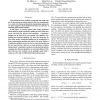Free Online Productivity Tools
i2Speak
i2Symbol
i2OCR
iTex2Img
iWeb2Print
iWeb2Shot
i2Type
iPdf2Split
iPdf2Merge
i2Bopomofo
i2Arabic
i2Style
i2Image
i2PDF
iLatex2Rtf
Sci2ools
ASPDAC
2001
ACM
2001
ACM
Optimal spacing and capacitance padding for general clock structures
Clock-tuning has been classified as important but tough tasks due to the non-convex nature caused by the skew requirements. As a result, all existing mathematical programming approaches are often trapped at local minimum and have no guarantee of obtaining global optimal solution. In this paper, we present optimal clock tuning algorithms which effectively apply capacitance-padding to reduce clock skew, power, and delay for general clock topologies. Capacitancepadding can be achieved by wire-spacing, wire-splitting, wirepadding and transistor-padding. We show that under the Elmore delay model, capacitance-padding can be formulated as a linear programming problem and solved with great efficiency. Capacitance-padding can also be used as a post processing step for any non-zero-skew clock tree or mesh structure to achieve timing closure. Experiment results on several practical industry examples show that our algorithms are extremely efficient. Problems with over
| Added | 23 Aug 2010 |
| Updated | 23 Aug 2010 |
| Type | Conference |
| Year | 2001 |
| Where | ASPDAC |
| Authors | Yu-Min Lee, Hing Yin Lai, Charlie Chung-Ping Chen |
Comments (0)

